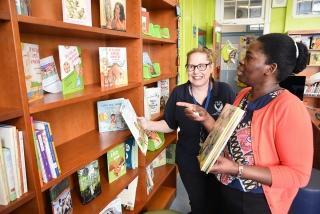Lisa Kent, the chapter leader at PS/IS 155 in Bedford-Stuyvesant, Brooklyn, has taught there for 22 years. In all that time, the school has never had a working library.
That finally changed this spring, thanks to the school’s current and former principals, community grants and donors, PTA volunteers and the tenacity of art teacher Lisa Ryan. On March 6, the school community gathered for a ribbon-cutting to unveil a library stocked with $10,000 worth of brand-new books.
What will it mean for students and teachers to have access to their school’s own library?
“It’s going to mean everything,” says Kent.
In our politically fraught times, as the rise of social media has made gathering reliable information more challenging, libraries are experiencing a renaissance. In a New York Times opinion piece in September, sociologist Eric Klinenberg declared, “To restore civil society, start with the library.”
Decades of research known cumulatively as the “school libraries impact studies” tell us that schools with strong library programs produce students with better standardized test scores in reading, stronger information literacy skills and higher graduation rates.
This holds true even in schools that have experienced an overall decline in staff or where a high percentage of students live in poverty.
Library impact studies also tell us that school library programs are most effective when certified library media specialists work hand in hand with teachers.
“Library impact studies suggest test scores tend to be higher where administrators, teachers and librarians themselves think of the librarian as a school leader; as a teacher, co-teacher and in-service professional development provider; as a curriculum designer, instructional resources manager and reading motivator,” wrote researchers Keith Curry Lance and Debra E. Kachel in 2018.
But finding space, staff and resources for a well-maintained library can be a challenge. In New York State, regulations require secondary schools — but not elementary schools — to be staffed by certified library media specialists, also called library teachers.
“A certified librarian is someone who’s been certified both as a librarian and as a teacher,” says Nira Psaltos, a librarian at Bayside HS in Queens. “Just like you would see a specific doctor for a specific ailment, a librarian is a teacher who’s been trained and who is coming from a place of expertise.”
Much of what library teachers are trained to do is help students build the information and digital literacy skills they need to conduct research and gather information — especially on the internet. Librarians help students understand how to evaluate information they find online and point them in the direction of resources they can trust.
“We provide knowledge that students need to know about navigating a complex information landscape,” says Michael Dodes, a school librarian who now works as a library operations and instructional coordinator in the city Department of Education’s Office of Library Services. “We focus on three pillars: inquiry, or the process of problem-solving; reading for pleasure and purpose; and social responsibility, or how to use information responsibly.”
Librarians can also be invaluable sources of support to classroom teachers. Librarians can help teachers gather a range of texts to meet diverse student needs. They also work with teachers to spark students’ interest in reading and support students as they evaluate content they encounter in their research.
“Librarians know where the best resources are, they know how to teach and they know how to teach teachers,” says Dodes. “They’re a central point to bringing together pedagogy and resources aligned to students’ needs.”
Most high school libraries are designed to be “open access,” meaning students can visit the library whenever they are free. In addition to the academic resources the library can provide, Psaltos says there’s value in the library as a welcoming space where students can hang out and read for pleasure.
“Every student should have access to the library and the opportunity to go there,” says Dodes. “It’s all about creating a space where students can read, explore information and work with each other.”
The skills students develop in their school libraries — as they learn to compare the merits of Wikipedia with ERIC, for instance — will continue to serve them far beyond the classroom.
“We get information, but we then have to process that information and use it ethically and responsibly — not just in an academic sense, but in a life sense,” says Psaltos. “Social responsibility and who we become as citizens is part of what libraries shape.”
